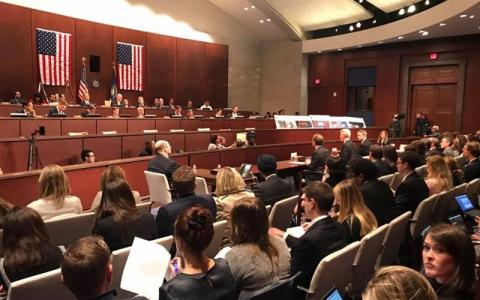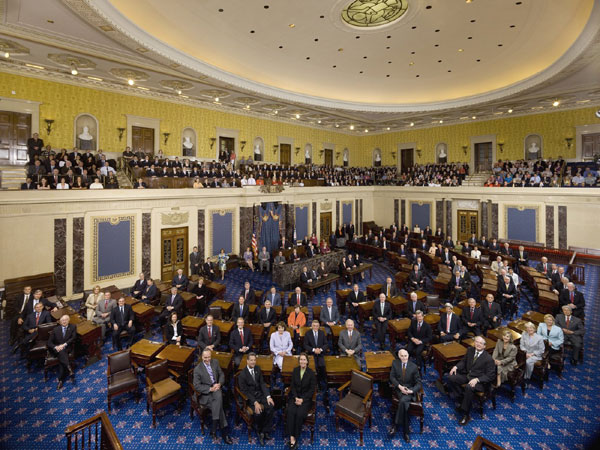House Republicans Pass Stopgap Bill to Prevent Government Shutdown: Senate Faces Crucial Decision
Input
Modified
The Stopgap Bill: A Temporary Solution to a Looming Crisis The Senate’s Role: Will It Approve or Block the Bill? The Political Battle: Shutdown Threat and Its Consequences

The Stopgap Bill: A Temporary Solution to a Looming Crisis
As the looming threat of a government shutdown continues to stir political tensions, House Republicans have passed a critical stopgap funding bill aimed at averting the imminent crisis. With a deadline approaching, the bill's passage in the House has momentarily staved off fears of an immediate shutdown, but the battle is far from over. This maneuver is not just about securing funding for government operations; it’s also a strategic move in the larger political struggle between Republicans and Democrats, with the fate of the bill now lying squarely in the hands of the Senate.
The funding bill passed in the House is a product of intense political maneuvering, with pressure mounting from all sides. Notably, former President Donald Trump has played a pivotal role in rallying Republicans to pass the legislation, creating a significant ripple effect within the party. By pushing for the bill’s swift passage, House Republicans are showing their resolve to ensure that the government remains operational, at least for the time being. However, the situation remains delicate, and the Senate’s response will determine whether this temporary solution is enough to avoid a full shutdown.
The bill passed by the House is not a long-term solution; rather, it is a stopgap measure designed to buy more time and prevent a shutdown, which would have far-reaching consequences on government services and employees. Set to last for six months, the stopgap bill is essentially a temporary patchwork solution that allows the government to continue functioning while Congress works on a more comprehensive funding agreement.
The bill includes various provisions, including funding for key government programs, but it also reflects the Republicans’ broader agenda. Some of the funding allocations are targeted at defense and border security, two issues that are central to the Republican platform. At the same time, the bill includes certain cuts and constraints on non-defense discretionary spending, which Democrats have criticized as inadequate for addressing the needs of vital social programs.
For Republicans, this bill is a victory, at least in the short term. It allows them to avoid the immediate consequences of a shutdown, which could damage their political reputation and erode public support. However, for Democrats, the bill’s passage is a mixed blessing. While they are relieved that a shutdown has been averted, they remain wary of the bill’s provisions and the implications for the broader budget negotiations.
The funding bill passed by the House Republicans is designed to maintain government operations for the next six months, but its contents have raised concerns. According to reports, the bill includes a range of provisions aimed at satisfying the Republican base, but it also presents challenges for the Senate.
Among the most significant elements of the bill is the allocation of funds for national defense, which is a priority for Republicans. The bill also includes funding for border security, which is another key issue for the party. These provisions are intended to shore up support from conservative voters and ensure that the party’s priorities are reflected in the legislation. However, the bill also imposes spending caps on various domestic programs, which has led to opposition from Democrats. The cuts to social programs, including healthcare, education, and housing, have drawn criticism from liberals who argue that they will disproportionately affect vulnerable populations.
In addition to the funding provisions, the bill includes several other measures aimed at addressing long-standing Republican concerns. These include efforts to reduce government regulation, limit spending, and enforce stricter immigration policies. The House Republicans have argued that these measures are necessary to restore fiscal discipline and ensure that taxpayer dollars are being spent responsibly. However, critics contend that these provisions undermine critical services and disproportionately affect low-income Americans.

The Senate’s Role: Will It Approve or Block the Bill?
Now that the bill has passed the House, it is up to the Senate to determine its fate. Senate Democrats have expressed concerns about the bill’s contents, particularly the cuts to domestic programs and the focus on defense spending. While some Democrats may be inclined to support the bill to avoid a shutdown, others are staunchly opposed to the funding cuts and the lack of support for social programs.
The Senate is unlikely to pass the bill in its current form, given the political divisions between Republicans and Democrats. However, if the Senate does pass the bill, it would mark a significant win for the House Republicans and a potential shift in the broader budget negotiations. The passage of the bill could also have implications for future legislative battles, particularly as lawmakers continue to grapple with issues related to federal spending and the national debt.
The political ramifications of this funding bill are significant, as a shutdown would have far-reaching consequences for the economy and government services. A shutdown would disrupt federal operations, halt government contracts, and delay vital services such as Social Security payments, veterans’ benefits, and military operations. With this in mind, both parties are under tremendous pressure to reach a resolution, but the path forward remains unclear.

The Political Battle: Shutdown Threat and Its Consequences
While the passage of the stopgap bill is seen as a temporary victory for Republicans, it only delays the inevitable budget showdown that will take place in the coming months. If the Senate does not approve the bill or if the provisions are modified, the possibility of a government shutdown still looms large. Should that happen, the consequences could be severe, affecting millions of Americans who rely on federal services and programs.
A government shutdown would also have economic consequences, as it would disrupt the flow of government contracts and services. For businesses that depend on government spending, a shutdown would create uncertainty and could lead to financial losses. Furthermore, the broader economy could suffer if the government is unable to function effectively. Federal workers would also be affected, with many facing furloughs or delays in pay. The disruption caused by a shutdown could have long-lasting effects on public trust in the government and its ability to function effectively.
The battle over the funding bill is not just about securing government operations; it is also a reflection of the broader political divide between Republicans and Democrats. Republicans are focused on reducing government spending, limiting regulation, and prioritizing defense, while Democrats are advocating for increased funding for social programs and a more balanced approach to fiscal policy. The political stakes are high, as both parties seek to demonstrate their ability to govern effectively and meet the needs of the American people.
This divide is not new. For years, Republicans and Democrats have struggled to find common ground on issues related to government spending, national defense, and social services. The funding bill passed by the House is just the latest battleground in this ongoing conflict. While both sides recognize the need to avoid a shutdown, they remain deeply divided on how to address the country’s fiscal challenges.
The House’s passage of the stopgap funding bill is a temporary measure designed to avert a government shutdown, but it only delays the inevitable showdown between Republicans and Democrats over federal spending. The bill includes provisions that are likely to be contentious, and the Senate’s response will be critical in determining whether a shutdown can be avoided. While the passage of the bill is seen as a victory for Republicans in the short term, the broader political battle is far from over. The stakes are high, as the outcome of this funding dispute will have significant implications for the country’s fiscal future and the ability of the government to function effectively.





















